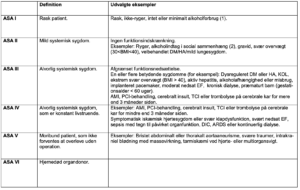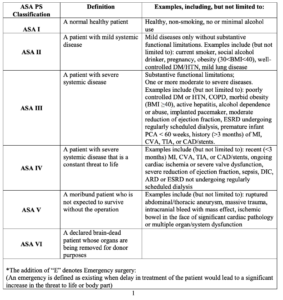ASA KLASSIFIKATION / DANSK OVERSÆTTELSE

DASAIMs fortolkning:
1. Minimalt alkoholindtag svarer til SST’s 7/14 genstande om ugen for hhv kvinder og mænd.
2. Alkoholindtag i social sammenhæng svarer til SST’s 14/21 genstande om ugen for hhv kvinder og mænd.
FORKORTELSER:
BMI: Body Mass Index
DM: Diabetes Mellitus
HA: Hypertensio Arterialis
KOL: Kronisk Obstruktiv Lungelidelse
EF: Ejection Fraction
AMI: Akut Myokardie Infarkt
PCI: Perkutan Coronar Intervention
TCI: Transitorisk Cerebral Iskæmi
DIC: Dissemineret Intravaskulær Coagulation
ARDS: Akut Respiratorisk Distress Syndrom
Oversat af DASAIMs anæstesiudvalg november 2015.
Godkendt af DASAIMs bestyrelse november 2015.
ASA PHYSICAL STATUS CLASSIFICATION SYSTEM
Last approved by the ASA House of Delegates on October 15, 2014
Table 1: Current definitions (NO CHANGE) and Examples (NEW)

Appendix 1
References related to use of the ASA PS Classification System
1. Guidelines for the use of Sedasys by non-anesthesia trained proceduralist and nurse. http://www.sedasys.com/
2. American College of Surgeons’ proposed guidelines for care of pediatric surgical patients. Journal of the American College of Surgeons, 2014;218:479-48
3. Guidelines for local anesthesia cases in a major academic center. “Monitoring patients receiving local anesthesia”, MGH, Perioperative Nursing, OR L. 16
4. Office Based Procedure guidelines https://phpmm.org/Portals/79/WebFiles/Provider%20Manual%20Updates/Clinical%20Guidelines/MQIC%202009%20Office-Based%20Surgery%20Guideline.pdf
5. Preoperative testing guidelines. http://www.choosingwisely.org/doctor-patient-lists/american-society-of-anesthesiologists/
Appendix 2
Selected References Addressing Inter-Rater Reliability of the ASA PS Classification System
1. Owens WD, Felts JA, et al. ASA physical status classifications: A study of consistency of ratings. Anesthesiology. 1978;49:239–43 (Editorial by Keats AS. The ASA Classification of Physical Status – A Recapitulation. Anesthesiology 1978;49:233-6)
2. Haynes SR, Lawler PG. An assessment of the consistency of ASA physical status classification allocation. Anaesthesia. 1995;50:195-9
3. Mak PH, Campbell RC et al. The ASA physical status classification: inter-observer consistency. Anaesth Intensive Care 2002;30:633-40
4. Aronson WL, McAuliffe MS, Miller K. Variability in the American Society of Anesthesiologists Physical Status Classification Scale. AANA J. 2003;71:265–74
5. Jacqueline R, Malvivya S et al. An assessment of interrater reliability of the ASA physical status classification in pediatric surgical patients. Paediatr Anaesth 2006;16:928-31
6. Burgoyne LL, Smeltzer MP. How well do pediatric anesthesiologists agree when assigning ASA physical status classifications to their patients. Paediatr Anaesth 2007;17:956-62
7. Bernard PA, Makin CE et al. Variability of ASA physical status class assignment among pediatric sedation practitioners. Int J Adolesc Med Health 2009;21:213-20
8. Cuvillon P, Nouvellon E et al. American Society of Anesthesiologists’ physical status system: a multicentre Francophone study to analyse reasons for classification disagreement. Eur J Anaesthesiol 2011;28:742-7
9. McMillan M, Brearley J. Assessment of the variation in American Society of Anesthesiologists Physical Status Classification assignment in small animal anaesthesia. Vet Anaesth Analg. 2013 May;40(3):229-36
10. Sankar A, Johnson SR et al. Reliability of the American Society of Anesthesiologists physical status scale in clinical practice. Br J Anaesth 2014 Apr 11 (epub ahead of print)
Indholdsfortegenelse
